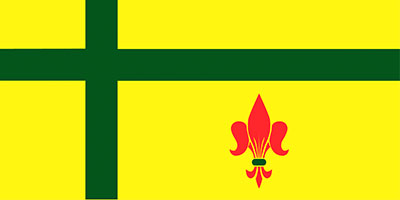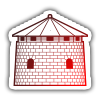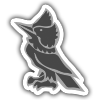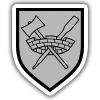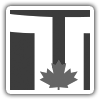Saskatchewan, Canada
Flag
The flag of Saskatchewan was adopted by the provinces legislative assembly in 1969. The flag is divided horizontally with the upper half featuring a green field and the lower a gold field. The green represents the northern forested area, and the gold represents the southern grain field area. The Saskatchewan shield of arms appears in the upper hoist of the flag and the fly is charged with the provincial flower, the western red lily.
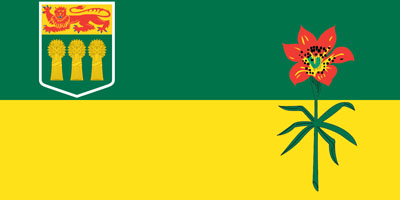
Other Provincial Symbols
- Floral Emblem: The Western Red Lily
- Tartans: Saskatchewan District Tartan/Dress Tartan
- Tree: White Birch
- Grass: Needle-and-Thread
- Bird: Sharp-tailed Grouse
- Animal: White-tailed Deer
- Mineral: Potash (Sylvite)
- Sport: Curling
- Fish: Walleye
- Fruit: Saskatoon Berry
Coat of Arms
Saskatchewan's shield of arms was granted in 1906 by King Edward VII. The crest, supporters and motto were granted in 1986 by Queen Elizabeth II.
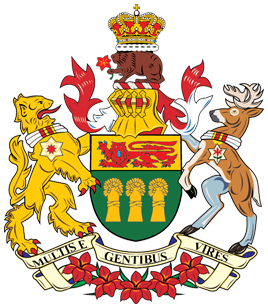
The top of the shield of arms features a red lion, a traditional royal symbol, on a horizontal gold band; the middle and lower parts of the shield feature three gold wheat sheaves on a green background, symbolizing Saskatchewan's agriculture and resources.
The shield is supported by a royal lion and a white-tailed deer, an animal indigenous to Saskatchewan. Both supporters wear collars of Prairie Indian beadwork. From each collar hangs a badge in the form of the six-pointed star (stylized lily) of the Saskatchewan Order of Merit. The badge worn by the lion displays Canada's emblem, the maple leaf, while the badge worn by the deer displays Saskatchewan's official flower, the western red lily.
Immediately above the shield is a helmet, which represents Saskatchewan's co-sovereign status within Confederation. The helmet is decorated with mantling in Canada's national colours - red and white. Above the helmet is a wreath that supports a beaver - Canada's national animal. The beaver represents the North, the fur trade and the provinces native people. The beaver holds a western red lily, the floral emblem of the province. The Crown, a symbol of Saskatchewan's direct link with the Sovereign through the Lieutenant Governor, surmounts the beaver at the top of the coat of arms.

Origin of the Name
The Cree name for the Saskatchewan River was "Kisiskatchewanisipi," meaning "swift-flowing river". Through common use, this eight-syllable name was shortened to Saskatchewan. In 1882, it became the name of one of the districts of the Northwest Territories.

History
Saskatchewan was originally inhabited by First Nations of the Athapaskan, Algonquian and Siouan linguistic groups. Three Athapaskan nations lived in the north: the Chipewyan, the Beaver and the Slavey. Two Algonquian nations - the Cree and the Blackfoot - occupied the central part of the province. The south was inhabited predominantly by the Siouan nations - the Assiniboine and the Gros Ventres. The influence of Aboriginal peoples in Saskatchewan is evident from the great variety of Aboriginal place names across the province.
Because the prairie, which makes up much of the province, was of little monetary interest to the early fur traders, southern Saskatchewan was relatively untouched by Europeans for many years. The northern wooded regions, on the other hand, were dotted with fur-trading posts early in Canadian history. The first explorer was Henry Kelsey, an employee of the Hudson's Bay Company, who followed the Saskatchewan River into the plains of Saskatchewan in about 1690.
Both Britain and the Province of Canada sent expeditions in the mid-1800s to explore the area and assess its agricultural potential. The Dominion Lands Act of 1872, combined with legislation to stimulate immigration, strongly encouraged homesteaders in Saskatchewan. In the 1880s, the newly constructed Canadian Pacific Railway brought settlers to farm the rich land. A great wave of immigration from Eastern Europe swept across the area in the late 19th and early 20th centuries.
In 1905, the Province of Saskatchewan was formed by joining parts of the districts of Saskatchewan, Athabaska and Assiniboia. It became the only province with boundaries not based on any particular geographical features. Saskatchewan and its neighbouring province of Alberta also share the distinction of being the only Canadian provinces that are not bordered by salt water.
Agriculture, particularly wheat and other cereal crops, but also oilseeds and livestock, continues to be the mainstay of the Saskatchewan economy. The province has 40 percent of Canada's farmland and produces 60 percent of the country's wheat. However, the economy is increasingly diversified thanks to the wealth of mineral resources: Saskatchewan has half the world's potash reserves, Canada's largest heavy oil reserves, coal, gold, and rich uranium deposits. The one million inhabitants of Saskatchewan, about 3.3 percent of Canada's population, reflect the ethnic diversity of Aboriginal, British, German, Ukrainian, Scandinavian, French and other peoples. The largest city is Saskatoon, which has a population of 224,000. Regina, the seat of government, has a population of 193,000.

Civic Flags
Regina, Saskatchewan
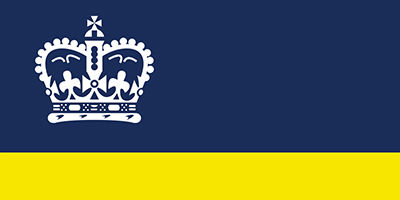

Fransaskois Flag
